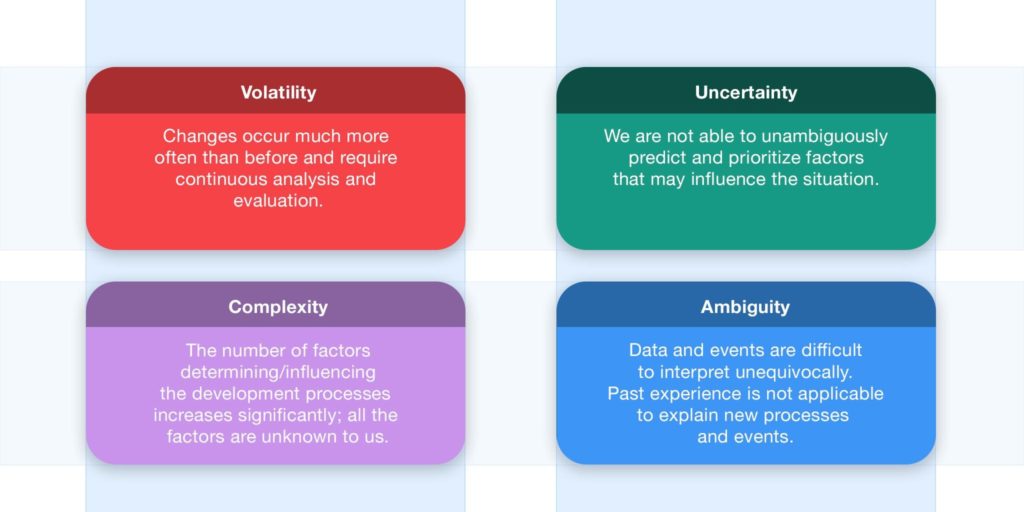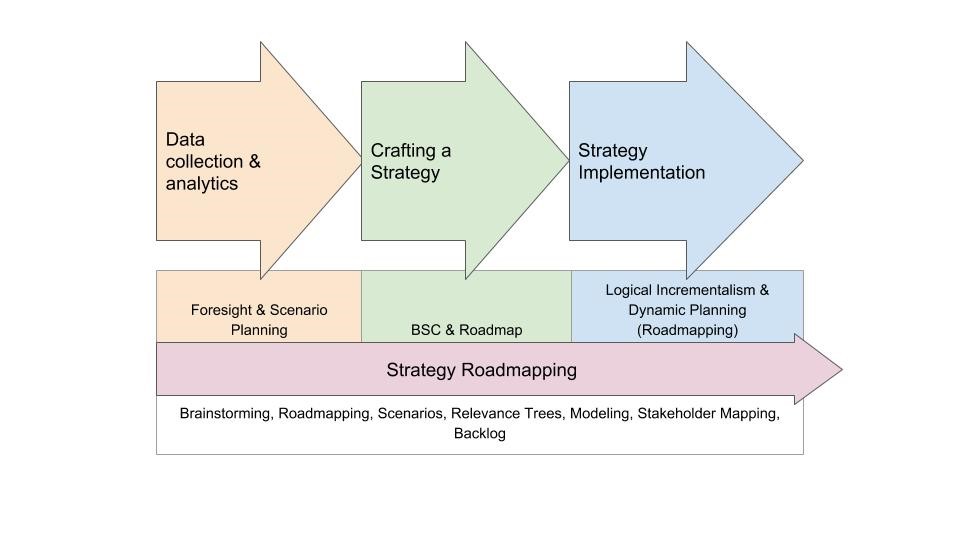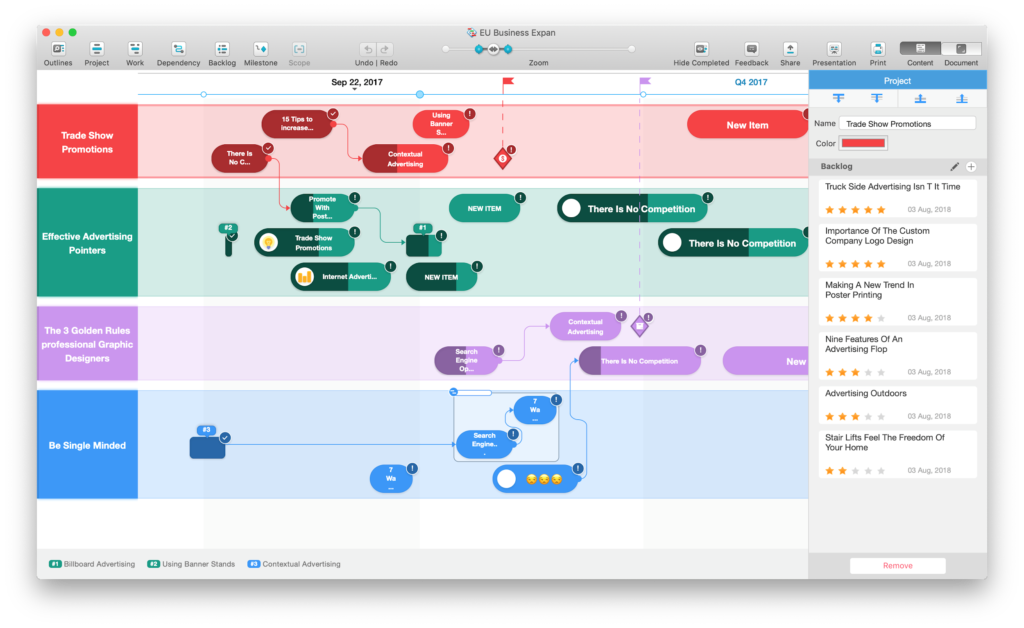“The future is not some place we are going, but one we are creating. The paths are not to be found, but made. And the activity of making them changes both the maker and the destination”
― John Schaar
Welcome to the VUCA world
The famous researcher of randomness, probability, and uncertainty Nassim Taleb calls the modern pace of change in the world lethal for any organization. It’s becoming harder and harder to predict at what time and in what form the threats and opportunities may arise. These and other similar characteristics of the modern world can be described by the term VUCA world.
We owe the term “VUCA” to Army War College, where, in 1987, it was defined as “the strategic leadership environment in terms of volatility, uncertainty, complexity, and ambiguity.” This definition was adopted by the strategic business leaders to describe the chaotic, turbulent, and rapidly changing business environment that has become the new normal (Kishinger, P & Walch, K, 2012).

Strategic Management in the VUCA world
Strategic management, even in a stable environment, has always been the center of discussion. The optimistic estimate of researches who explored business strategy implementation failure rates was around 50%. The cost of mistakes in the VUCA world is deadly. To achieve goals, companies now need to make greater efforts.
It is logical to assume – and the research confirms it – that in general terms, all survival techniques in the VUCA world are connected with the principle of continuous adaptation and permanent learning of organizations.
Henry Mintzberg in his book Strategy Safari: A Guided Tour Through The Wilds of Strategic Management divided strategy into two groups. The first one is prescriptive and the other group is descriptive schools.
Prescriptive schools of the Strategy have been dominating the business community since the 50s. It is a program where the stages of planning and execution were two different tasks separated in time. Such a strategy could become outdated even before its very implementation. This approach could be effective in a stable environment, but it is absolutely inconsistent with the demands of the VUCA world.
Among the descriptive schools of strategic management, there was at least one based on the principles of continuous adaptation and permanent learning – the Learning School. The ‘father’ of this school, Charles E. Lindblom, introduced the world the method of successive comparisons operating with a limited number of alternatives, on the basis of which an effective temporary solution can be made. This flexible method became known as incrementalism.
Incrementalism
Incrementalism is a management approach consisting of regular small steps and decisions. This is a pragmatic way of interacting with reality and balancing opportunities and risks. The logic of incrementalism was at the heart of some descriptive schools of a strategy and also was close to the principles of Japanese Kaizen system of continuous incremental improvement, pioneered by Toyota in the 1970s.
Incrementalism implies that the leader forms the way in general terms. They should clearly develop the final goal and intermediate results – the stages of goal achievement. Assuming that several goals can lead to one goal, and that selection efficiency is a derivative of specific external circumstances, the incrementalism approach leaves room for maneuvers and a wide choice of methods for the goal realization.
Incrementalism is highly effective in the conditions of the VUCA world due to the following reasons:
- it uses chains of small changes
- small steps are clearer for the task performers and do not cause their resistance
- small changes can lead to the goal faster than large ones
- it eliminates big risks
- it provides organizations with the higher level of flexibility and adaptability
The weak points of incrementalism are fragmentation and the lack of precise rules of its application:
- the solutions are used to solve problems, not to use opportunities
- the solutions are local, often unrelated, and may even contradict each other
- Incrementalism is characterized by ‘Strategic drift’: gradually, without even noticing it, an organization may deviate from the adopted strategy.
Essentially, incrementalism has one major drawback – instead of developing resources and preparing for market breakthroughs, the company is tempted to take small steps. Let’s call this avoidance of big bets. Without the ability to make big bets, the competition will constantly eat up the company’s profits right up to its bankruptcy. Incrementalism becomes dangerous for a company when risk avoidance becomes its norm.
3 Tools for the VUCA world

In one of his interviews, Nassim Taleb called the loss of contact with reality as one of the key problems of our time. After all, the more accurately a company is able to realize the real state of things, the more effective are its actions.
The VUCA world requires a revision of how businesses collect and analyze information, make strategic decisions, develop plans and implement them.
1) Speaking of the First Stage – Data Collection and Analytics
VUCA world requires consideration of greater amount of factors and expansion of the planning horizon. As a result, there’s a growing popularity of forecasting methods, which can be united under the concept of foresight.
Foresight is different from the traditional predictive models called forecasting. While forecasting is based on the forward projection of past experiences. Foresight includes more advanced methods of anticipation logic which allow making possible scenarios based on weak signals, emerging trends, coexisting presents and potential paths of evolution. Strategic foresight is especially useful in situations that are characterized as a VUCA context.
The foresight process is closely related to another important tool in the VUCA world – scenario planning. As it was already mentioned, one goal can be achieved in different ways. When developing a strategy, management team chooses the most likely turn of events based on the available information, resources, skills, etc. At the same time, any strategy bears the imprint of information incompleteness and subjectivity, such as cognitive predispositions of decision makers. However, what if things don’t go as planned?
The scenario is a holistic plan, a set of assumptions that describes an alternative view of the future, which is then used to develop or to test a strategy. Scenario planning is mainly focused on answering two questions: ‘What can happen?’ and ‘What impact will it have?’ The company’s readiness for several future development options will allow it to be less fragile.
2) The second Stage – Crafting a Strategy
It is the most subjective one and in many schemes is depicted simply as a black box. This is a stage when the strategy itself is created. In most cases, it is a plan of initiatives based on a chain of goals – a scorecard implemented in Balanced Scorecard (BSC) approach, introduced by Robert S. Kaplan and David P. Norton.
At this stage, strategists may face many challenges: treating the symptom vs. sorting around, making false assumptions, making a false shot a short frame, lacking buy-In… There are even more problems in the conditions of the VUCA World.
3) The Third Stage – Strategy Implementation
The critical factor for both the crafting strategy stage and the next stage of strategy implementation is the gap between strategy and execution when “the plan remains the plan”.
One of the modern methods of solving above-mentioned problems is a dynamic strategic plan which should be continually refined and improved.
The study on the application of dynamic planning principles carried out by SAP evidence an increase in the accuracy of forecast fulfillment and improvement in company productivity: 40% greater average customer profit margin, 29% improvement accuracy of actual revenue to budgeting revenue.
The most complete application of dynamic planning principles can be achieved with the help of such strategic management tool as roadmapping.
Roadmapping
Among all of the VUCA tools, roadmapping most fully implements the ideas of dynamic planning, continuous adaptation and learning.
The main feature of roadmapping is that it fully implements the principles of logical incrementalism and dynamic planning. Roadmap is a dynamic strategic map that answers three questions:
- where do we go? (specifying the quantitative and qualitative measurement of goals)
- where are we now? (basing on the assessment of key performance indicators of the company)
- action-plan itself
Roadmapping allows companies to remain flexible in their choice of tools and methods for the goal achievement, maintaining their focus on strategic goals mostly through the use of milestones.
Another vital feature of roadmapping is that it is both a strategy and a mean of communication. Bernard Marr considers lack of communication as the top reason leading the strategy to the failure: “Strategies are not communicated effectively so nobody understands them”. Rob Phaal from Cambridge Roadmapping emphasized that “the process of roadmapping is more important than the roadmap itself”. Being a flexible tool that simplifies the integration of initiatives, roadmapping supports strategic dialogue and provides a better understanding of strategic goals and ways to achieve them. At the same time, it remains one of the best ways to communicate ideas.
Roadmapping is about the collective clarification and understanding of goals and strategies of product development. As a result, the company gets a transparency of the long-term vision, on which then, day after day, your managers and your team will string effective solutions and initiatives. The future will definitely differ from the way we imagine it, that’s why we should paint with the large strokes.

Conclusion
VUCA world is a complex and controversial place. On the one hand, it encourages companies to innovate and search for new solutions. On the other hand, too quick adaptation requires simplification. That’s why sometimes for the purpose of survival, organizations tend to simplify their products and reduce their development time.
Effective behavior in the VUCA world relies on predicting the trends of all key factors that affect business (foresight) as well as on rational, controlled processes of continuous learning and adaptation. At the same time, the management team should always keep in focus the company’s strategic goals and milestones.
Responses to the VUCA events are hidden at the junction of organization and reality. The very strength of any strategy is not its strictness and consistency, but its ability to effectively use opportunities and to act accurately in the face of uncertainty.
Roadmapping with a set of unique qualities such as transparency, visibility, and tunability to the strategic goals and milestones, is an excellent tool for managing the future in VUCA conditions, which are now the new norm and due to which we have to learn new efficiency and accuracy.
Author Bio: The author of the article is our Director of Product Development, Andrey Drozhzhin. He is a Master of Business Administration with over 20-year experience in business development. Strategic management is his great passion. He currently leads our strategic-planning project, Roadmap Planner.














